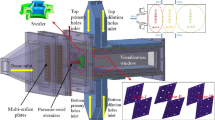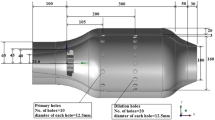Abstract
In order to achieve the good unification of combustion performance and low emission of high temperature rise combustor, RQL technology was applied to the design of high temperature rise combustor in this paper. Three-dimensional physical models of combustor were set up by referring to the structure and size of experimental model, and the influence of primary holes spacing on the flow and combustion characteristics were studied by using simulation under the conditions of room temperature and atmospheric pressure. The simulation results show that with the increase of primary holes spacing, the angle of primary jets gradually inclines to the upstream, and the vortex centers of local recirculation in rich zone approach to the primary jets. Meanwhile, the number of local recirculation zones in the quench zone also varies with the primary holes spacing. The optimum design of primary holes spacing not only improves the mixing effectiveness of airflow in the quench zone, but also enhances the combustion in rich zone. The optimum holes spacing is related to the combustor height and the momentum flux ratio of primary jets to mainstream. In addition, under the optimum structure of primary holes spacing (Case-3 model), the range of local hot spots at outlet was smallest, the combustion efficiency and the emission index of NO at the equilibrium of kinetic rate of chemical reaction were about 0.06% higher and 12% lower than the other two models, but the formation of soot and CO along the rich zone were slightly higher.










Similar content being viewed by others
References
Mongia H (2011) Engineering aspects of complex gas turbine combustion mixers part I: high ΔT. In: 49th AIAA aerospace science meeting including the new horizons forum and aerospace exposition, Orlando, Florida
Mongia H (2011) Engineering aspects of complex gas turbine combustion mixers part II: high T3. In: 49th AIAA aerospace science meeting including the new horizons forum and aerospace exposition, Orlando, Florida
Mongia H (2011) Engineering aspects of complex gas turbine combustion mixers part III: 30 OPR. In: 9th annual international energy conversion engineering conference, San Diego, California
Bahr DW (1987) Technology for the design of high temperature rise combustors. J Propul Power 3(2):179–186
Mongia H (1997) Gas turbine combustion design, technology and research—current status and future direction. In: 33rd AIAA/ASME/ASEE joint propulsion conference and exhibit, Seattle, WA
Mongia H (1998) Aero-thermal design and analysis of gas turbine combustion systems—current status and future direction. In: 34th AIAA/ASME/ASEE joint propulsion conference and exhibit, Cleveland, OH
Samuelsen GS, Brouwer J, Vardakas MA, Holdeman JD (2013) Experimental and modeling investigation of the effect of air preheat on the formation of NOX in an RQL combustor. Heat Mass Transf (49):219–231
McKinney RG, Sepulveda D, Sowa W et al (2007) The Pratt & Whitney TALON X low emissions combustor: revolutionary results with evolutionary technology. In: The 45th AIAA aerospace sciences meeting and exhibit, AIAA 2007, p 386
Lee CM, Chang C, Kamer S, Herbon JT (2013) NASA project develops next generation low-emissions combustor technologies. In: 51st AIAA aerospace sciences meeting including the new horizons forum and aerospace exposition, grapevine (Dallas/Ft. Worth Region), Texas
Jian C, zhong LJ, Li Y, Ge H (2019) Flow and flame characteristics of a RP-3 fuelled high temperature rise combustor based on RQL. Fuel (235):1159–1171
Van TV, Hwang JJ, Ahn KY (2016) Feasibility study of ultra-low NOX gas turbine combustor using the RML combustion concept. J Mech Sci Technol, 30(12):5749–5757
Mellor AM (1990) Design of modern turbine combustors. Academic Press, London
Lefebvre AH (2010) Gas Turbine combustion. CRC Press, New York
Richards CD, Samuelsen GS (1990) The role of primary jet injection on mixing in gas turbine combustion. In: Proceeding of the twenty-third symposium on combustion, pp 1071–1077
Richards CD, Samuelsen GS (1990) The role of primary jets in the dome region aerodynamics of a model can combustor. J Eng Gas Turbines Power 114(1):20–26
Elkady A, Jeng SM, Mongia H (2006) The influence of primary air jets on flow and pollutant emissions characteristics within a model gas turbine combustor. In: The 44th AIAA aerospace sciences meeting and exhibit, 2006, Reno, Nevada
Gogineni S, Shouse D, Frayne C et al (2002) Combustion air jet influence on primary zone characteristics for gas turbine combustor. J Propul Power 18(2):407–416
Mohammad B, Jeng SM, Andac MG (2011) Influence of the primary jets and fuel injection on the aerodynamics of prototype annular gas turbine combustor sector. J Eng Gas Turb Power 133(1): 011505.1–011505.8
Kartaev EV, Emelkin VA, Ktalkherman MG et al (2015) Formation of counter flow jet resulting from impingement of multiple jets radially injected in a crossflow. Exp Thermal Fluid Sci 68:310–321
Holdeman JD, Liscinsky DS, Samuelsen GS et al (1996) Mixing of multiple jets with a confined subsonic crossflow in a cylindrical duct. In: 41st gas turbine and aeroengine congress sponsored by the American society of mechanical engineers Birmingham, United Kingdom
Holdeman JD (1993) Mixing of multiple jet with a confined subsonic crossflow. Prog Energy Combust Sci 19(1):31–70
Holdeman JD, Liscinsky DS, Oechsle VL et al (1997) Mixing of multiple jet with a confined subsonic crossflow: part I-cylindrical duct. J Eng Gas Turbines Power 119(4):852–862
Holdeman JD, Liscinsky DS, Bain DB (1999) Mixing of multiple jet with a confined subsonic crossflow: part II-opposed rows of orifices in a rectangular duct. J Eng Gas Turbines Power 121(3):551–562
Liscinsky DS, Tue B, Holdeman JB (1996) Effects of inlet flow conditions on crossflow jet mixing. In: 32nd AIAA, ASME, SAE, and ASEE, joint propulsion conference and exhibit, Lake Buena Vista, FL
Bain DB, Smith CE, Holdeman JD (1995) Mixing analysis of axially opposed rows of jets injected into confined crossflow. J Propul Power 11(5):885–893
Leong MY, Samuelsen GS, Holdeman JD (1999) Mixing of jet air with a fuel-rich reacting crossflow. J Propul Power 15(5):617–622
Leong MY, Samuelsen GS, Holdeman JD (2000) Optimization of jet mixing into a rich, reacting crossflow. J Propul Power 16(5):729–735
Li JZ, Yuan L, Mongia H (2017) simulation investigation on combustion characteristics in a four-point lean direct injection combustor with hydrogen/air. Appl Sci 7(619):1–17
Mongia H (2008) Recent progress in comprehensive modeling of gas turbine combustion. In: AIAA Aerospace Sciences Meeting & Exhibit
Li JZ, Chen J, Yuan L et al (2019) Flow characteristics of a rich-quench-lean combustor-combined low-emission and high-temperature rise combustion. Int J Aeros Eng 2019(PT.1):4014120.1–4014120.22
Pan HY, Lei H, Han LL et al (2012) Analysis of the error in liquid-fuel ramjet combustion efficiency calculation. In: 18th AIAA/3AF international space planes & hypersonic systems & technologies conference. Tours, France
Acknowledgements
This work were supported by the national natural science foundation of china (No. 52166006), the natural science foundation of guizhou province (Grant No. ZK [2021]-279) and the open funds of jiangsu province key laboratory of aerospace power system (No. CEPE2019011).
Author information
Authors and Affiliations
Corresponding author
Additional information
Technical Editor: Mario Eduardo Santos Martins.
Publisher's Note
Springer Nature remains neutral with regard to jurisdictional claims in published maps and institutional affiliations.
Rights and permissions
About this article
Cite this article
Chen, J., Li, J., Hu, G. et al. Simulation investigation on flow and combustion characteristics in a high temperature rise combustor based on RQL under different primary holes spacing. J Braz. Soc. Mech. Sci. Eng. 43, 529 (2021). https://doi.org/10.1007/s40430-021-03250-8
Received:
Accepted:
Published:
DOI: https://doi.org/10.1007/s40430-021-03250-8




